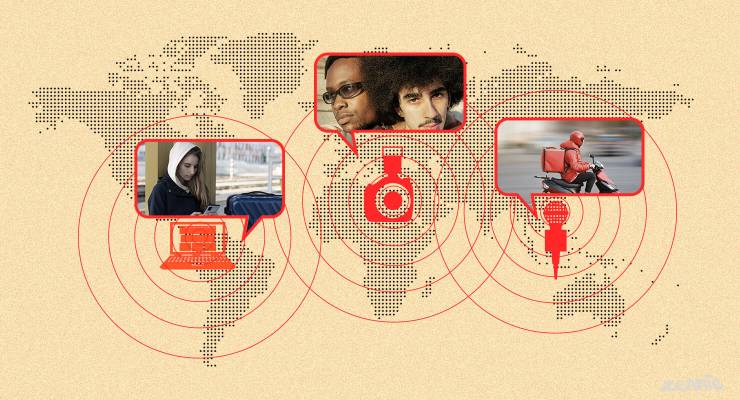
The writer is with a driver and courier, Rada, in Sarajevo in the early-morning dark:
At 6.05, just above Parkuša, we pick up a package. Dobrinja, 6.25, a young guy is waiting for us, he’s going to work in a hotel on the Albanian coast. Then at 6.30, in the Mojmilo neighbourhood, across from the King Fahd Mosque … we pick up a doctor … And then towards Pale, from where Ivana, a programmer, is heading to Belgrade for a work meeting and a family visit.
It’s the morning round for Rada, another link in “The Alternative Balkan Postal System” by Ilir Gashi, originally published in Serbian on Kosovo 2.0 and now a finalist in the European Press Prize.
The article tells the global story of the social disruption of contested borders, with an explainer of the informal distribution economy from the point of view of the workers and people who rely on buses, taxis and personal favours to keep communities and people connected across the western Balkans.
Why should we care? Because it’s a reminder there’s another way of doing journalism than the institutionalised, top-down, “the prime minister said today” approach that dominates Australia’s traditional media.
This year’s 30-strong shortlist for the European Press Prize — with winners to be announced next month — tells its own story: that large global trends are often told best on a small scale, from the perspectives of ordinary people caught in the middle. Right now, those stories — usually in emerging media — are telling us things we don’t know, deepening our understanding of our own lives.
Take Telex, an independent site set up in 2020 after staff walked out of Hungary’s top news site Index when it was taken over by an ally of autocratic prime minister Viktor Orbán. Telex is a finalist with a report by Luca Pintér (with great photos from Orsi Ajpek) on István and Tamás, among the last single-sex couples in Hungary allowed to adopt and who are now bringing up their twins in the face of mounting government-generated hostility to LGBTQIA+ people.
Journalist Alla Konstantinova for the Russian independent site Mediazona (founded in 2014 by Pussy Riot members Maria Alyokhina and Nadezhda Tolokonnikova) reported on one of the key stories from Russia’s invasion in Ukraine: the rape of teenage girls by Russian military, told from the perspective of the girls themselves. And in Ukraine itself, Anna Myroniuk and Alexander Khrebet write in The Kyiv Independent on rank-and-file soldiers on suicide missions, and abuse and physical threats in the country’s much-touted International Legion. (The presence of Australians in Ukraine has been an under-reported subject here.)
Sweden’s Aftonbladet (owned by Scandinavian media giant Schibsted) starts its report on the high price of cheap clothes through global supply chains right where it begins — in a Bangladeshi village: “If Soma Akhter, 25, wanted to, she could predict the colour of next year’s fashion,” the opening par snaps. “Just look at the water under her bamboo-stilt house. It glistens turquoise.”
The view from the bottom is fleshed out with global collaborations on major investigations. Collaborative network Lighthouse Reports used 140 videos and 40 interviews with survivors and state security forces to build a 3D reconstruction of the Barrio Chino post on the border of Spain’s North African enclave where 23 people died in last year’s Mellila massacre.
Another collaborative network, the Organized Crime and Corruption Reporting Project (OCCRP) worked with 24 partners to create the Russian Asset Tracker, “the most comprehensive audit ever published of property held outside Russia by oligarchs and senior officials close to Putin”. One example is the US$55 million French Riviera estate owned as part of the $10 billion in assets of former Chelsea Football Club boss (and now sanctioned) Roman Abramovich.
Reportage that tells the big stories from the point of view of people caught in the middle has always been a better way of doing journalism. It was at the centre of the rebirth of long-form magazine writing (aka New Journalism) in the 1960s. Over decades, it’s shaped the best of television reporting, like Four Corners.
But as traditional media have cut resources, Australian journalism has become dominated by a top-down orthodoxy that assumes a story isn’t a story until it’s a Canberra story. The return to basics by emerging media reminds us that, for real understanding, bottom-up reporting is often simply a better choice.
Disclosure: Christopher Warren is editor of the Coda Live journalism show in Tbilisi, Georgia next month. The show includes some European Press Prize finalists referred to in this article.








Good article. There may be hope for those underpaid and under-resourced reporters who are still trying to call truth to power.
Excellent journalism about excellent journalism
Don’t we need both top-down and bottom-up? The top-down picture tells us where the areas worth looking at are, e.g. which borders are contested.